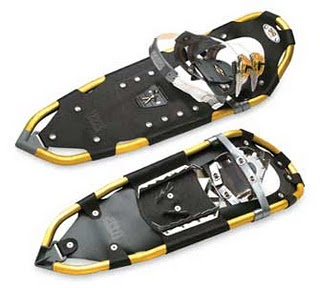
Short days and long winter nights mean hibernation mode has arrived for many of us. But the start of our season does not mean gray you have to turn into a sloth and put your metabolism to sleep until spring. Not sure what to do this winter? Here is a great activity that you should book into your fitness plan this year: Snowshoeing.
This winter activity is making a comeback in the world recreation and snowshoe technology has made leaps and bounds over the past decade. With new, lightweight materials, today's snowshoes will probably feel a lot different to you then they did when you first tried them during family outings as a child. Today's snowshoes are shorter and narrower than the wide-bodied, wood framed snowshoes of old. They feature lightweight aluminum frame and a special a decking. With the easy-to-use flexible-binding, and crampons on the bottom to prevent slipping, Snow Shoeing today can be a walk in the park.
The beauty of snowshoeing is that nearly anyone can do it. If you can walk, you can snow shoe. Snowshoe running is a different variety. This fast growing sport is a superb cross-training activity months for runners and other active people, during the winter. With less impact than road running, snowshoe running is a great way to strengthen the muscles of the legs and core without having to pound the pavement.
What you need to know to get started:
Type of Snowshoe. Depending on your activity goal, you can choose from snowshoes designed for running, back country, or general 'recreation'. Most people who want to get started will buy or rent recreational shoes.
Other Gear. Wear clothing that will wick away moisture such as polyester or lycra blends. Cotton is a no-no in cold weather as it gets wet and will hold moisture against your skin. Dress in layers So that you can remove clothing, as you get warmer. A pair of stable, waterproof hiking boots are a good bet if you are hiking. If you are running, a stable trail running shoe or a lightweight day hiking shoe works best. Many people use ski poles in the same way that a hiker does-to increase energy output due to additional upper body muscle use provides stability, and to decrease stress on knees, ankles and feet. Use leg 'gators' to keep snow out of your boots and keep your feet dry.
Make sure you bring your water bottle and some extra food for energy along the way. Other items include first aid kit, sunglasses, map, camera, matches, flashlight, compass / GPS (if you know how, to use it!) And a cell phone.
Fitness. Snowshoe walking is more difficult than walking on a cleared surface, but it is also as hard as you want to make it. Start gradually and progress to a more challenging pace as you get more miles on your snowshoes. Every workout should begin with a gradual warm-up and finish with a cool down to avoid injuries or soreness. End your adventure with a few stretches for the legs, hips, and arms before hopping back into your car.
Where to Go Safely. You can pretty much anyplace that you can snowshoe hike. Check your local tourism office or hiking club for ideas to get you started. Stick to well known snowshoeing trails snowshoe and always with a buddy for safety reasons. Always leave word of your route, and carry a cell phone for emergency contact.
Happy Trails!
Sarah Sead psr Kinesiology, is the owner of Equilibrium Lifestyle Management based in the Comox Valley, BC, Canada. She provides fun Fitness Adventures and Personal Training Services in person and online. For more information visit
Langganan:
Posting Komentar (Atom)


0 Response to "Snowshoes Have Grown Up, Too"
Posting Komentar